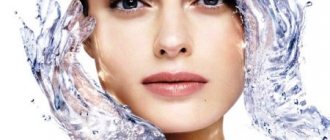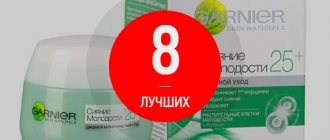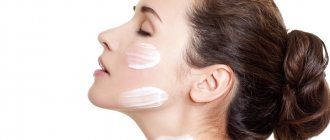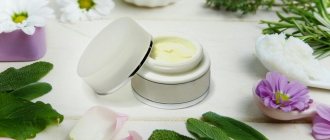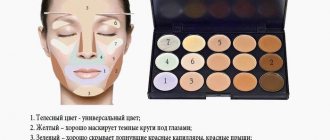Modern stores are full of a variety of different cosmetics. We don’t even know how to choose a face cream because our eyes are wide open. When trying to decide which face cream to choose, we focus on slightly wrong things: the popularity of the manufacturer, smell, cost, packaging. All this is also important, but not of paramount importance. In this article we will tell you how to choose a face cream and what you need to pay attention to.
Composition of a cosmetic product
At its core, a cream is a carefully mixed homogeneous mass of a base, beneficial substances for the skin (active components) and auxiliary ingredients (technical details).
Base
Respectable manufacturers use natural vegetable oils and their mixtures as a base; low-quality products are dominated by technical (mineral) oils obtained during the processing and use of petroleum products. The cream base is also a universal solvent for all other ingredients. It is better if the product is based on sesame or olive oil. Of no small importance is the uniformity of mass and particle size in the emulsion (this is what the consistency of a cream is called in chemistry). The more thoroughly the ingredients are crushed, the greater the likelihood that they will penetrate into the deep subcutaneous layers.
Important ingredients in terms of technical filling
The skin is a barrier to the external environment; it reliably protects against the influence of various factors (both unfavorable and beneficial substances of masks, creams). Therefore, the primary task for manufacturers is to find a way to pass this barrier, how to direct all the necessary substances into the deep subcutaneous layers so that they realize their function there. Cosmetologists come to the aid of synthetic substances that facilitate the process - technical elements. They increase the effectiveness of the cream and promote the penetration of these active components into the skin tissue.
Only 10-30 percent of the beneficial substances from products applied to the skin can reach its deep layers and improve the condition of the face. If you deprive the cream of synthetic impurities, then 1-5% of the active components will reach the goal.
It is not possible to choose a good face cream without such ingredients. Absolutely all cosmetic products contain:
- emulsifiers and stabilizers (responsible for maintaining the consistency of the product and preventing separation of the mass);
- preservatives (prevent natural ingredients from spoiling);
- thickeners (used to give the product a creamy structure, since natural vegetable oils are quite liquid);
- flavorings (designed to deodorize a cosmetic product and increase its aesthetic properties);
- dyes, etc.
Almost all of the listed components are produced synthetically, are not at all beneficial for the skin, but are indispensable in creams. The harmful effects of such substances have not been proven, but it is better to have as few of them as possible.
Active components
The content of substances of this group in the product determines the cosmetic effect of its use. The best cream (in terms of composition) should contain at least 4-5 names of natural extracts, extracts, oils, esters or other non-synthetically produced components. Moreover, it is absolutely not necessary to choose products with the presence of overseas plants (ginkgo biloba, jojoba, passion fruit, etc.). Plants of the usual climate have a similar effect: sea buckthorn, dill, cucumber, chamomile, calendula, etc.
Vitamins and microelements are added as active components, if they are included in the composition - this is another plus in favor of the product. The following substances may be present in specialized facial skin care creams:
- ceramides (naturally occurring fats that help retain moisture);
- antioxidants (relieve cells of free radicals);
- azelaic acid (provides a whitening effect).
Pseudoactive components
The cream may contain, at first glance, quite useful substances - coenzyme Q10, vitamin C, hyaluronic acid, collagen and the like. When they are present in the epidermis, a wrinkle smoothing effect and an antioxidant effect are actually observed. However, there is one big but: such ingredients are not absorbed into the skin:
- Vitamin C decomposes in air even before application to the face;
- Coenzyme Q10, hyaluronic acid and collagen have molecules that are too large to cross the skin barrier, etc.
conclusions
The use of face creams is an integral part of the skin care process. They help retain moisture in tissues, deliver nutrients to the deep layers of the skin, slow down the aging process and relieve all sorts of inflammatory problems. However, they must be applied and selected correctly. When purchasing, it is important to pay attention not only to the principle of action and purpose of the cream, but also to the age group and composition. The quality and effectiveness of the product may depend on this. It is best to make your choice after consulting a cosmetologist and dermatologist.
How to find the golden mean
Which face cream to choose so that it is truly beneficial for the skin, is highly effective and is not full of chemical impurities? The secret lies in the composition of the product. The closer to the beginning of the list a component is, the greater its share in the emulsion. Universal rules for choosing face cream:
- natural ingredients should be in the first half of the list;
- the composition should contain 3-5 components of natural origin;
- the number of chemical names in the list should be minimal;
- the cream must be suitable for your skin type;
- Do not buy a cream that does not have ingredients on the label.
Remember that professional cream acts quickly due to the high content of chemical components that enhance its effect. To do this, you need to choose the right manufacturer and type of cream that suits your skin. The effect of the natural remedy appears only a month or two after the start of regular use. Do not judge the cream after the first application (except for the feeling of obvious discomfort, an allergic reaction or rash) - the ingredients must work from the inside. The products have virtually no effect on already formed skin cells, and it takes time for the skin to renew itself.
This thematic video will help you make the right choice:
How to choose a quality face cream: what to look for when purchasing
There are some other things you should know:
- A high price is not a guarantee of quality. There are a lot of products on the market with an average or even low price that will care for your skin no worse than expensive products;
- If you decide to try a new manufacturer or line, first use a sampler and test the product for allergies on the crook of your elbow. This will save you from wasting money. If an allergy develops, it is easier to throw away the sample than a full jar;
- Packaging with dispensers or tubes is much more economical than jars;
- The expiration date is very important - be sure to check it before every purchase! You should not use cosmetics that have expired - you can seriously harm your skin and develop a serious allergy;
- The consistency should be uniform (if we are talking about cream). It should not delaminate, there should be no oily films or liquids on the surface;
- If the cream has too strong a smell or an unnaturally bright/dark color, it is better to discard it. This means that it either contains too many different fragrances and dyes, or they are too “chemical”. It’s great if the cream has a slight smell and a milky white color.
Types of creams by type of action
To choose the right face cream, you must first decide on the problem that is bothering you. It’s good if the skin is young and clearly has one or two problems (oilyness and acne, for example). The situation is much more complicated with mature skin, which already shows signs of aging (the first wrinkles), dryness, lack of elasticity and firmness of the face. To solve a complex of problems, you may need to purchase several tools.
There are several main types of facial care products based on their action:
- Moisturizers deliver moisture to the skin and retain it. On the surface of the face they form a thin film that binds water and directs it to the place of deficiency.
- Nutrients contain a large number of plant extracts, herbal extracts and the like. By increasing the proportion of nourishing ingredients, facial skin receives more vitamins and minerals. As a rule, nutritional products have a greasy texture and are used in the evening before bed.
- Fortified products are rich in vitamins of natural origin and synthetic production. In essence, this is the same nourishing cream, but with a lighter texture (less fat in the composition). From this series it is easy to choose an option for oily facial skin and for very young skin.
- Protective equipment protects from wind, cold, sun and the like. When used, a mechanical barrier is created on the skin, minimizing the adverse effects of the environment. They may contain wax, petroleum jelly, silicone and the like.
- Cleansing (exfoliating) preparations remove chemically or mechanically the stratum corneum, enhance the penetration of creams for other purposes, promote cell renewal, and improve the appearance of the skin.
- Regenerating ones contain ingredients that promote skin cell regeneration. To replenish the skin's need for nutrients, they contain plant extracts and vitamins. To prevent aging and fading of the face, the composition includes substances that trigger the production of collagen and elastin inside the cells.
- Anti-aging creams are used if the process of skin aging has already started and its harmful effects, as they say, are “obvious”.
Which choice to prefer
A woman should have several types of care products on her dressing table, and young women are no exception. They can be divided into categories:
- for daily use;
- for use as a course;
- for occasional use.
Daily care
Every day you should use two types of facial cosmetics: for the night and for the day. Night cream can be restorative, nourishing or fortified (depending on the needs of the skin and its type). It will restore the skin, saturate it with useful substances, nourish and care for it during rest (this way the benefits will be maximum). The composition of the emulsion for the night should be rich; it is at this time of day that the surface of the face is most responsive to external influences.
Choosing a daily facial product is also not a big problem. Of course, any day cream must contain UV protection. In winter and off-season it is better to prefer a protective agent. In the warm season, it is advisable to select products with a light texture from the line of moisturizers. But the cream must match your skin type so as not to aggravate existing problems.
Course application
In adulthood (after about 35-40 years), it is advisable to use restorative agents in a course of a month or two. This will prevent skin aging, wrinkles, dryness and other problems. The older a woman gets, the more frequent and longer the courses should be. After 50 years, they can be transferred to the category of daily.
At a younger age, courses use vitaminized or nutritional products (depending on the main choice). This way the skin is more fully saturated with the necessary substances and its appearance is improved.
Occasional use
Once or twice every 7 days, it is advisable to deep clean the skin - use exfoliating agents. They should be selected individually; it is better if they are produced by one company, although the use of products from different cosmetic concerns is allowed.
Each age has its own composition
You can’t use one single product your entire life. It should change and meet the needs of the skin at a given time. The cosmetics industry has simplified this problem by releasing several lines of products designed for different ages. But you should not blindly trust the manufacturers - always read the label, select the product solely based on its composition.
Withering processes begin after 25 years. The body stops growing, the mechanisms of recovery and intensive cell renewal slow down. At 35, the aging processes are gaining momentum, they are still practically not manifested externally, but it is necessary to wage a thorough fight against them from the inside. The skin is still smooth and attractive, but hormonal changes will "fix" its appearance over time.
At the age of 45+, fading becomes a clear problem, the oval of the face falls, the cheeks shift, the contours seem to blur. The process is intensified by rapidly changing hormonal levels. It's time to use the heavy artillery - products with an anti-age effect.
The purpose of face cream, the difference between night and day cream, how often it needs to be changed. All this in the video below:
If you have oily skin...
... Then careful care will be required at any age. The main problems of owners of this type are wide pores, blackheads, comedones and inflammation. But why does your skin have so many problems? It's all about increased sebum production. But don't rush to get upset. Your skin has one important advantage: it ages slowly.
Do you want to preserve beauty and minimize problems? Then the first thing you need to do is stop looking for the best cream for oily skin. The key to clear skin is gentle cleansing, proper toning and nutrition/moisturization. And no errors like these:
- Squeaky cleansing. This will only increase sebum production and lead to dehydration.
- Squeezing pimples. Remember once and for all: you cannot squeeze pimples, as you spread the infection.
- Wiping with a towel. Don't rub your face, just blot the moisture.
- Refusal of oils and creams. Oily skin needs oils with polyunsaturated fatty acids.
Price
Average cost of face creams:
- nourishing cream can be purchased at a price of 100-30,000 rubles;
- a cream with a mattifying effect will cost 80-8000 rubles;
- protective cream will cost between 200-5000 rubles;
- a cream with a tonic effect is sold at a price of 70-15,000 rubles;
- moisturizer can be bought for 130-24,000 rubles;
- creams with anti-aging effect cost up to 40,000 rubles;
- anti-wrinkle cream can be purchased at a price of 200-27,000 rubles;
- a cream that increases skin elasticity will cost 40-19,000 rubles.
